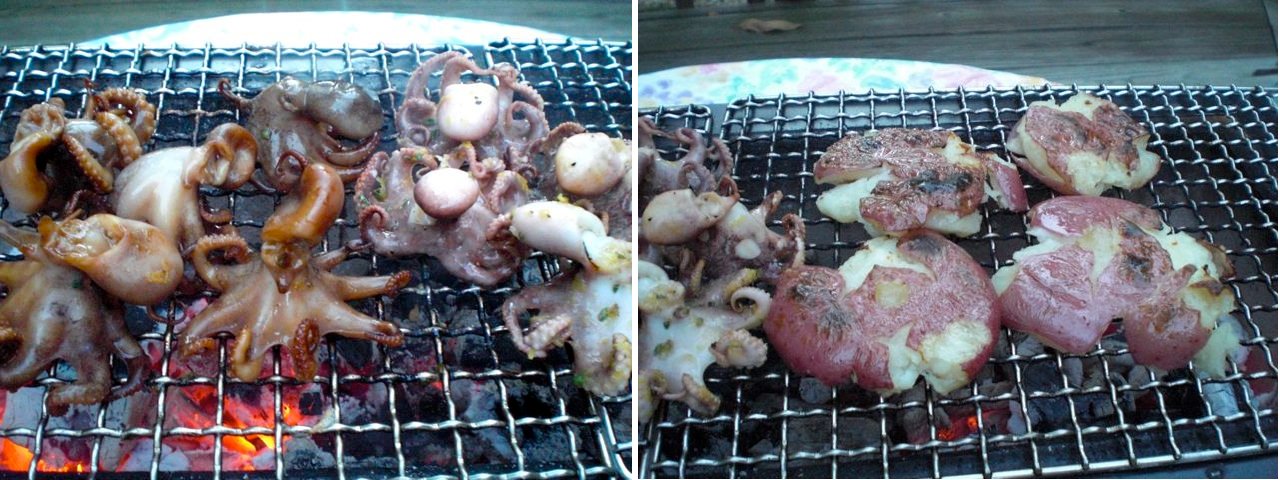This is certainly not Izakaya food. But I thought, just in case there are some Japanese readers out there,
acorn squash and
artichokes may be a bit unusual for them.
Artichoke is a very strange vegetable (if it is a vegetable). It is the immature flower bud of a giant thistle. Whoever (must have been Europeans) decided this could be eaten, must have been very hungry. In terms of its strangeness and the fact that it is a flower bud, it is on par with
myouga 茗荷. I didn't cook artichokes myself until I moved to California from the east coast many, many moons ago. We fondly remember driving through Half-moon Bay on the California coast, one of the major artichoke producing regions of the United States. We often stopped at one of the many road side stands to buy fresh artichokes just harvested from the fields that extended either side of the road. After moving back to the east, the artichokes we see at the market are usually pitiful and we only rarely buy them. Last weekend, I found some reasonably good looking artichokes and I could not resist buying them, but I did not have a chance to prepare them right away.
My wife came to the rescue and she prepared the artichokes along with acorn squash the following Friday. I only had to cook the rack of lamb that went along with them for dinner.
Artichokes: There are many ways to cook artichokes (which also depend on the size of the artichokes). The most classic old fashioned way for regular size artichokes is what we did this evening.
How to clean and prepare artichokes is readily available elsewhere. My wife steamed them for 45 minutes in water to which lemon juice, onion, black pepper corns, bay leaf and olive oil had been added. The picture above shows the cooked artichoke served on the plate. What it doesn't show are the many outer petals that were already eaten in transit between pot and plate (It went swimmingly well with a sip of the red wine we were having).

To eat, remove a petal, the edible portion is attached only to the bottom inside of the petal (above image, upper left), dip it in a whatever dip you like (the above image, upper right, is mayonnaise with lemon juice, but you could use melted butter as well) and using your front teeth, scrape off the edible portion (above image, lower left). When you get into the more immature inner petals, not much edible portion is attached. You then remove all the petals exposing the "chokes" (which, I suppose, eventually become the fluffy cottony stuff attached to the seeds to be carried by the wind). As the name implies, you do not want to put these chokes into your mouth. They are not named "chokes" for no reason. The name describes how you will feel if you attempt to eat it--choked. You must carefully remove all the chokes using a knife or spoon or both. You end up with the heart of the artichoke (the above image lower right, this one is already quartered). Actually, this is the meatiest and the best part of the plant. This is what the previous work was all about. The taste of artichokes is difficult to describe. We like it very much but you would have to taste it and decide for yourself.
Acorn squash: It is a very popular fall vegetable and my wife cooked it in the traditional American way but seasoned it with a Japanese touch. She cut the squash in half and removed the guts (seeds and inner membranes). She washed it under running water (leaving some water inside). The water puddles under the squash and steams it as it bakes. She then placed them on a flat cooking sheet with the cut-side down. The squash baked in a 350F oven for 45 minutes. She scraped all the meat out of the shells and put it in a bowl. She added butter, honey, and soy sauce (in lieu of salt), mixed well and then stuffed it back into the half shells. This tastes somewhat like mashed sweet potatoes but different. It has a mildly sweet taste yet is savory at the same time. This was a perfect side for the lamb (or more like, the lamb is perfect side for the squash).
Rack of lamb: This was seasoned with salt, pepper, and fresh rosemary. identically seasoned as
ones in my previous post but I did not marinate and, instead of an electric grill, I browned it in a frying pan and finished it in an oven (350F 5-8 minutes).
Between the artichoke, squash, and lamb we noticed that this meal resulted in an unusually large amount of debris on the plate by the time we were finished. Doesn't this look the epitome of a good feast thoroughly enjoyed? In case you were wondering, it was.

The wine we had this evening was
Benessere Vineyards Napa Valley Phenomenon 2005. This is a California red blend Super Tuscan style and made of Cab Sauv (47%), Sangiovese (27%), Merlot (14%) and syrah (12%), all from St. Helena estate-grown fruits. It is not like classic Napa cab with strong vanilla and chocolate but has a more subtle but complex taste. The tannin is now nicely matured giving a nice backbone to this California Super Tuscan. We like this wine very much. It went so well withthe lamb and artichokes. Perfect for tonight dinner.


